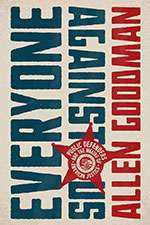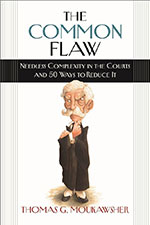 VERDICT: Touchdown!
VERDICT: Touchdown!
Everyone Against Us: Public Defenders and the Making of American Justice
By Allen Goodman (Univ. of Chicago Press, 2023). 222 pgs. $21.75. Order, www.amazon.com.
Reviewed by Frederic W. Knaak
This book by Allen Goodman describing his career over 20 years as a Chicago public defender is easily one of the best books I’ve read by a lawyer describing the experience of his practice in the 45 years I’ve been a lawyer.
Normally, maintaining candor without lapsing into cant or self-adulation, not to mention a career of writing mind-numbingly dull prose, makes it nearly impossible to write any kind of readable autobiography. George Orwell underscored the point when he said, “Autobiography (is) only to be trusted when it reveals something disgraceful. A man who gives a good account of himself is probably lying, any life when viewed from the inside is simply a series of defeats.”
Want to Review a Book?
Please request a book and writing guidelines from the Wisconsin Lawyer managing editor at wislawmag@wisbar.org. Reviewers may keep the book reviewed. Reviews of about 500 words are due within 45 days of receiving the book. Reviews are published, space permitting, in the order received and may be edited for length and clarity.
Goodman’s book does not exhibit this flaw. Goodman’s description of his 20 years as a public defender is unsparing. It is also fascinating and painful for any reader to experience in its intense candor and unblinking first-hand observation of how “the system” works in practice. He describes, as a matter-of-fact observer, the corruption, racism, and wholesale injustice regularly practiced by police officers, prosecutors, and judges in criminal courts. Readers whose practices include criminal law will see familiar patterns when they are led through the cavernous big-city lockups and soul-jarring crime scene investigations into the world of chambers discussion where the fates of accused individuals routinely get decided.
We often forget that even in cases in which the perpetrator of an uncommonly horrific crime is involved, a lawyer, usually a public defender, is present. “We are the ones who are appointed to shepherd those cases through the process where there is no defense, where the actions of the defendant are legally and morally indefensible, and the outcome is an inevitable, if drawn out, formality … [i]t takes a special soul,” he notes, “to do the job professionally.” Not to mention avoiding burnout after a short time.
Goodman’s observations are even more blunt and unsparing when he writes about the role of victims’ advocates in domestic violence matters. His assessment is damning:
“They seemingly never even tried to consider that they might be enabling manipulators and perpetuating victimization of defendants who were devastated by false claims. That’s the ether of official self-righteousness. Those advocates, whose very existence assumed the truth of the victimhood proposition that was not yet proved, simply did not have any professional ethical constraints. Crucially, although they were allowed to speak on the record despite not being professionally licensed or sworn to an oath, they were not subject to any requirement that they only present information they reasonably believed to be correct or had investigated in any way. They never had to pay a price for being wrong, so they never bothered to weigh the consequences of their actions in any nuanced way.”
Goodman shares his experiences with cases ranging from relatively minor traffic enforcement matters to capital cases (Illinois has a death penalty). His excellent prose and writing style give the book the feel of an on-the-job legal drama. I found it hard to put down.
By way of contrast, I sent a copy to my public defender son to get his feedback. He didn’t get far into it: it was too much like work to be enjoyable. That may well be the reaction of others who are deeply involved in the justice system in Wisconsin.
As for the rest of us, I can’t recommend this book enough as a clear view of the difficult road public defenders are on in the criminal justice system every day. Without being in any way preachy or sermonizing, Goodman’s superb book very effectively underscores that important point and made me grateful for the lawyers who take on this often-thankless job. WL
Frederic W. Knaak, Minnesota 1978,practices with North Star Law Group in Saint Paul, Minn.
 VERDICT: Not for Me, Maybe for You
VERDICT: Not for Me, Maybe for You
The Common Flaw: Needless Complexity in the Courts and 50 Ways to Reduce It
By Thomas G. Moukawsher (Waltham, MA: Brandeis Univ. Press, 2023). 240 pgs. $29.95. Order, www.amazon.com.
Reviewed by Freya K. Bowen
Thomas G. Moukawsher, formerly a judge on the Connecticut Superior Court and now retired, argues that the legal system has lost its way by indulging in a rigid and soulless formalism, which he dubs “needless complexity.” He urges that judges and lawyers alike should return the law to a type of compassionate humanism, returning fairness and humanity to litigants’ experience of the judicial system (even when they do not win) and restoring public faith in the integrity of the courts and democratic institutions. Although this intriguing premise is paired with lively and engaging writing, the book is ultimately a somewhat disappointing grab-bag of loosely connected admonitions that doesn’t deliver on its promise. Moukawsher claims his advice is geared toward lawyers and judges, but while the heart of the book contains excellent suggestions for judicial reform, the advice for lawyers largely boils down to “write better briefs and come up with alternative fee arrangements.”
Moukawsher focuses on “fifty practical steps” for improving civil litigation consisting of 51 chapters adorned with wry New Yorker-style cartoons. Unfortunately, the 50-step structure seems strained, with chapters often becoming repetitive as the author reaches for different ways to reiterate aspects of several broad themes, leaving the 50 theses jumping around within these themes. This is particularly ironic given the author’s call for greater conciseness and clarity in writing and his callout of multifactor tests as an example of “needless complexity.” (See chapter 36: “Reduce Judicial Testiness: Use Multipoint Tests Only When Each Point Has Meaning.”)
Although Moukawsher champions the rule of law, he downplays or outright disparages reliance on precedent, criticizing how varying outcomes result from applying a given legal principle to different facts, though this is the very mechanism by which the common law develops over time. “Slavish obedience to misperceived precedent is the sin of substituting mimicry for judgment,” he writes. He urges a more “humane” approach relying on “common sense” and counsels that “an effective judge … is more like a village elder.” Unfortunately, despite the author’s welcome exploration of the sometimes-abusive nature of the legal system, and the need to safeguard minority rights, he doesn’t acknowledge the hazards of untethered “judgment” and “common sense,” including how these concepts have historically been weaponized against marginalized groups.
Moukawsher is at his best when discussing judicial reform, and his thoughtful discussion of various case-management best practices (clearly informed by his years on the bench) will likely be of interest to judges and lawyers involved in court-reform efforts. Even on this topic, though, some of the “practical steps” need much more development to be practical, such as the suggestion that federal courts abandon their parsimonious understanding of subject-matter jurisdiction and standing, focusing instead on resolving cases on the merits.
Overall, if Moukawsher abandoned the gimmicky “fifty steps” framework and expanded his discussion of judicial reform, where his passion clearly lies, the book would be well worth reading by all lawyers and judges. As written, the book will be of interest mainly to readers searching for specific suggestions regarding judicial reform.
Freya K. Bowen, Berkeley Law 2002, is a partner at Lindemann Miller Bowen LLP, Chicago, focusing in insurance coverage litigation. She formerly clerked on the Ninth Circuit Court of Appeals for Judge Sidney R. Thomas. She lives in Madison and is also an adjunct professor at the University of Wisconsin Law School.
» Cite this article: 97 Wis. Law. 66-67 (May 2024).
